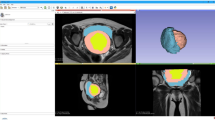Abstract
The anatomy of the pelvic floor is complex and difficult to visualize from conventional two-dimensional anatomy pictures. The goal of this project was to establish the methods necessary to develop a static three-dimensional virtual reality model of the normal female pelvic floor from high-resolution magnetic resonance imaging (MRI) scans. An asymptomatic nulliparous 23-year-old female with no urinary incontinence symptoms underwent a high-resolution pelvic floor MRI scan. Selected pelvic floor structures were manually segmented: bladder, urethra, vagina, uterus, cervix, levator ani, obturator externus, obturator internus, and pubic bone. With high-resolution scans, accurate segmentation of the structures was possible. The completed models were displayed on an ImmersaDesk Virtual Reality system and three clinicians verified their accuracy. Stereovision glasses were used to enhance the model while a receiver tracked head position. Three-dimensional virtual reality models of the female pelvic floor can enhance our understanding of anatomy and physiology of this complex part of the body. They can be used as tools for both research and teaching, facilitating improved treatment of pelvic floor pathologies.
Similar content being viewed by others
References
Axtell, R. L. Why Agents? On the Varied Motivations for Agent Computing in the Social Sciences. Proceedings of the 8th IEEE International Conference and Workshop on the Engineering of Computer Based Systems. The Institute of Electrical and Electronics Engineers Computer Society, Los Alamitos, California, 2001.
Beyersdorff, D., T. Schiemann, M. Taupitz, H. Kooijman, B. Hamm, and V. Nicolas. Sectional depiction of the pelvic floor by CT, MR imaging and sheet plastination: Computer-aided correlation and 3D model. Eur. Radiol. 11:659-664, 2001.
Burkel, W. E., and R. Woodburne. Essentials of Human Anatomy. New York: Oxford University Press, 1994.
Fielding, J., H. Dumanli, A. Schreyer, O. Shigeo, D. Gering, K. Zou, R. Kikinis, and F. Jolesz. MR-based three-dimensional modeling of the normal pelvic floor in women. Am. J. Radiol.174:657-660, 2000.
Fielding, J. R., D. J. Griffiths, E. Versi, R. V. Mulkern, M. L. T. Lee, and F. A. Jolesz. MR imaging of pelvic floor continenece mechanisms in the supine and sitting positions. Am. J. Radiol. 171:1607-1610, 1998.
Freed, K., A. Weider, V. Low, J. Heneghan, and C. Spritzer. Magnetic resonance imaging in the evaluation of the pelvic floor musculature in patients with and without pelvic floor dysfunction. Proc. Int. Contin. Soc., Denver, CO, 1999.
Hole, J. Human Anatomy and Physiology. Dubuque, IA: WCB, 1981.
Hoyte, L., L. Schierlitz, K. Zou, G. Flesh, and J. Fielding. Two-and 3-dimensional MRI comparison of levator ani structure, volume, and integrity in women with stress incontinence and prolapse. Am. J. Obstet. Gynecol.185:11-19, July 2001.
Letterie, G. Medical education as a science: The quality of evidence for computer-assisted instruction. Am. J. Obstet. Gynecol. 188:849-853, 2003.
Moore, K. and A. Dalley. Clinically Oriented Anatomy. New York: Lippincott Williams and Wilkins, 1999.
Muscatello, D. J., C. Rissel, and G. Szonyi. Urinary systems and incontinence in an urban community: Prevalence and associated factors in older men and women. Int. Med. J. 31:151-160, 2001.
Panepento, Peter. The Perfect Swarm. Computerworld. 2001. Available at www.computerworld.com.
Pearl, R., R. Evenhouse, M. Rasmussen, F. Dech, J. Silverstein, S. Prokasy, and W. Panko. The virtual pelvic floor, a tele-immersive educational environment. Proc. AMIA Symp. 345-348, 1999.
Rasmussen, M., T. Mason, A. Millman, R. Evenhouse, and D. Sandin. The virtual temporal bone, a tele-immersive educational environment. Future Gen. Comput. Syst. 536:1-6, 1998.
Singh, K., M. Jakab, W. Reid, L. Berger, and L. Hoyte. Three-dimensional magnetic resonance imaging assessment of levator ani morphologic features in different grades of prolapse. Am. J. Obstetrics Gynecol. 188:910-915, 2003.
Stec, A. A., H. K. Pannu, Y. E. Tadros, P. D. Sponseller, E. K. Fishman, and J. P. Gearhart. Pelvic floor anatomy in classic bladder extrophy using 3-dimensional computerized tomography: Initial insights. J. Urol. 166:1444-1449, 2001.
Tan, I. L., J. Stroker, A. Swamborn, K. Entius, J. Calame, and J. Lameris. Female pelvic floor: Endovaginal MR imaging of normal anatomy. Radiology 206:777-783, 1998.
Tunn, R., J. O. DeLancey, E. Quint. Visibility of pelvic organ support system structures in magnetic resonance images without an endovaginal coil. Am. J. Obstetrics Gynecol.184:1156-1163, 2001.
Weidner, A. C., and V. H. Low. Imaging studies of the pelvic floor. Obstet. Gyn. Clin. N. Am. 25:825, 1998.
Author information
Authors and Affiliations
Rights and permissions
About this article
Cite this article
Parikh, M., Rasmussen, M., Brubaker, L. et al. Three Dimensional Virtual Reality Model of the Normal Female Pelvic Floor. Annals of Biomedical Engineering 32, 292–296 (2004). https://doi.org/10.1023/B:ABME.0000012749.79488.d6
Issue Date:
DOI: https://doi.org/10.1023/B:ABME.0000012749.79488.d6




